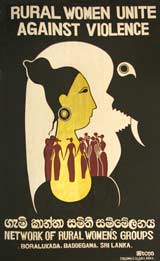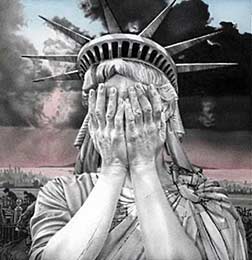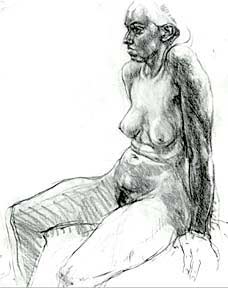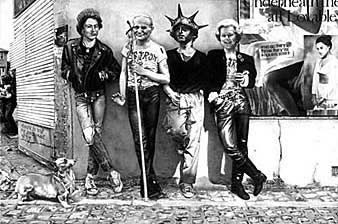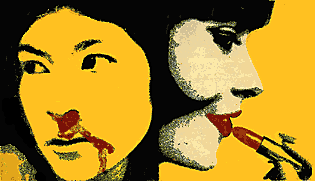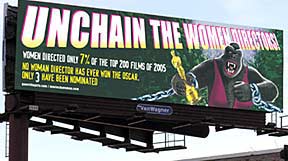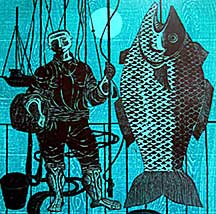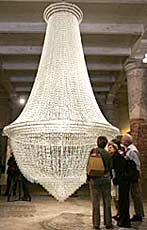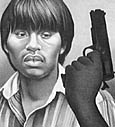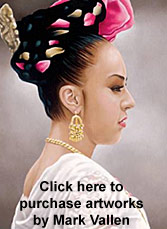Wack! Art and the Feminist Revolution, opens March 4th, 2007 at the Geffen Contemporary of the Los Angeles Museum of Contemporary Art, and runs until July 16th, 2007. Organized by MOCA curator Connie Butler, the show features artworks created from 1965 to 1980, by 100 women focused on the status and liberation of women. In one attempt to capture the militant spirit of late 60's feminist groups, Butler named her show,
Wack!, which is not itself an acronym, but alludes to the popularity of acronyms used by radical groups of the period, my favorite example being the tongue in cheek,
W.I.T.C.H., or - Women's International Terrorist Conspiracy from Hell.
Wack! is being promoted as "the first comprehensive, historical exhibition of feminist art", and you could add "international" to the billing as around half of the artists are from outside the U.S. - including artists from England, Poland, Scandinavia, Germany, Algeria, India, Canada, Italy, Chile, and Brazil. Many talents - well known and unknown - are in the show, and an excellent illustrated catalog published by MOCA covers all the bases, however, in this article I’d like to focus on just one participating artist - Martha Rosler.
During the early 1970’s I discovered Rosler’s photomontage series, Bringing the War Home: House Beautiful, a brilliant, multi-faceted, intrinsically feminist critique of American involvement in Vietnam. The title of Rosler’s collection was a melding of a popular 60’s antiwar slogan in the U.S. ("Bring the War Home!"), to the vapid women’s magazine of the period that promoted homemaking as the proper area of interest for women. Rosler’s compelling and influential photomontage works seem more powerful than ever - especially since we are mired in a new Vietnam. I was delighted to learn that Rosler’s works were recently included in Media Burn, an exhibition at London's Tate Modern, and even more excited to discover that she’s rekindled the Bringing the War Home: House Beautiful series - this latest edition being focused on Iraq.
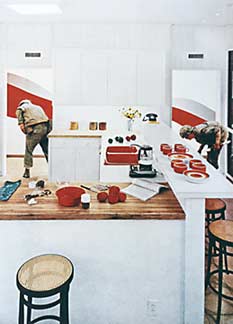
[ Red Stripe Kitchen - Martha Rosler. Photomontage. 24 x 20 inches. From the series, Bringing the War Home: House Beautiful. 1962–72. For a larger view of this image, click here. ] Red Stripe Kitchen was a photomontage from the original 1962 - 72 series. In it, Rosler combined two photos to startling effect. The first, a circa 1970 interior shot of an affluent household’s modern home kitchen, decorated in the fashionable modernist style; gleaming white from floor to ceiling, with a breakfast bar seating arrangement surrounding the stove. Adjacent doors lead to a pantry. The dazzling white is interrupted by red highlights found in dishes, appliances - and a decorative stripe painted mid-level on the pantry wall. The second photo spliced into this tranquil scene explodes the myth of domestic bliss. Two combat ready Marines are snooping around in the pantry, engaged in the same type of search performed by U.S. soldiers a million times over in Vietnamese villages suspected of aiding Viet Cong guerillas. Aside from exposing the kitchen as a battlefield, Rosler’s photomontage directly linked women’s oppression to militarism and overseas imperial adventures - but it also posed a thousand questions. Who is the enemy? Who is innocent? Who shall be absolved of guilt and responsibility in times of war?
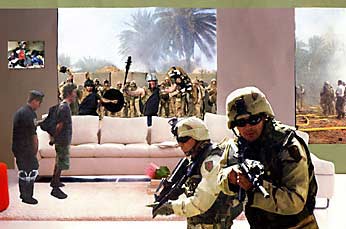
[ Gladiators - Martha Rosler. Photomontage. 2004. From the new series, Bringing the War Home: House Beautiful. For a larger view of this image, click here. ] In
Gladiators, one of Rosler’s current works from the Iraq series, the bourgeois home has not only turned out to be invaded, its interior has become inseparable from the mayhem outside its walls. In the living room of the spacious home depicted, a framed artwork hangs; a photo of bloodied Iraqi civilians heaped in a pile, a crystal-clear indication that we are living with the war in our daily lives without really seeing it. The quiet of the affluent residence has been shattered by a police officer, who is apparently arresting a member of the household while heavily armed U.S. soldiers conduct a search and destroy mission through the dwelling. That one of the soldiers is raising his automatic weapon towards the viewer is a disquieting reminder that the war has indeed - come home.
Viewers of Gladiators may be confused by the chaotic panorama glimpsed through the abode’s huge bay windows. In part it is obviously a distressing Iraqi street scene where smoke from a detonated car bomb wafts by palm trees, but who are the odd looking men rushing the house as they brandish clubs? The photograph depicting them is not a readily identifiable image, even though it’s an Associated Press photo that was widely circulated on the internet. The image documents U.S. Marines of the 1st Division in Iraq, dressed as gladiators and - like a scene from Charlton Heston’s, Ben Hur - holding chariot races with filched Iraqi horses. The bizarre incident occurred at a Marine military base outside of the doomed city of Fallujah on November 6th, 2004, the very eve of the Marine attack that would destroy the "insurgent stronghold" of 300,000 civilians. If you find this all too hard to believe, you can see the original AP photos here, as well as read Agence France-Presse’s account of the Marine’s evangelical pre-Fallujah pep rally.
The Geffen Contemporary of the Los Angeles Museum of Contemporary Art, is located in downtown Los Angeles near Little Tokyo, at 152 North Central Avenue. LA, CA. 90013. Visit them on the web, at: www.moca.org. MOCA has also constructed a special website for the exhibition, a "collaborative environment for consciousness-raising and discussion." At MOCA's WACK! site, "the general public, artists, and authors can participate in the discourse by posting responses to artworks."
Labels: Artists and the Iraq war, Feminist art
